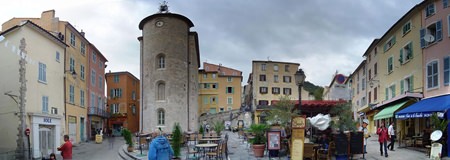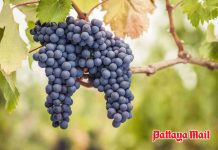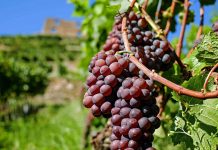The other night we were talking about wine yet again, and someone brought up the subject of French VDQS wines. The category was created in 1949 and must have seemed a good idea at the time, because it filled an awkward gap between the cheap Vin de Table wines and those of higher quality. As things turned out, it didn’t really catch on with the result that in 2011 the VDQS category was ditched completely. But that wasn’t all. The old Vin de Table category, which had been struggling on for years, was also given the heave-ho in 2010.
Incidentally, I’ve noticed that many specialist wine websites still haven’t got the facts right and provide information that’s already five years out of date. Let’s get it sorted out once and for all. So please sit up straight and try and look as though you’re interested, for I shall explain this only once.
 The centre of Hyères (Photo: Bichot de Paris).
The centre of Hyères (Photo: Bichot de Paris).
The French have been re-thinking their wine classification system since 2006 and new categories came into force in 2012. There are now three French wine categories rather than the previous four, so that in itself is good news. Let’s start at the top of the three and work down, for it won’t take long. The top category is the new AOP (Appellation d’Origine Protégée) which indicates the geographical origin, quality and style of the wine, but you’ll see the older AOC (Appellation d’Origine Contrôlée) for years to come especially on wines with a long life. The best wines of France come into this category and you might sometimes see the words Grand Cru, Premier Cru or Premier Grand Cru Classé on more expensive bottles. These refer either the plot of land where the grapes were grown or the château where the wine was made.
At the next level down we have wines labelled Indication Géographique Protégée (“Protected Geographical Region”) usually known as IGP. This category is used throughout Europe and focuses on geographical origin, giving winemakers greater stylistic freedom than AOP. Vin de Pays wines, meaning “wine of the land” or “country wine” have been absorbed into this IGP category. Wine-makers can choose whether to show Vin de Pays or IGP on their labels but many show both.
At the bottom of the tree, there’s the Vin de France category, which represents the most basic wines and replaces the defunct Vin de Table. Wine-makers are allowed to show a grape variety and a vintage year on the label but not any specific region. These wines are nearly always sold under a brand name and they can offer excellent value.
Château Castel des Maures 2013, Côtes de Provence AOP (rosé), France (Bt. 695 @ Foodland)
Provence has specialised in making rosé for centuries and it’s the home to some of the best rosés you can buy. This splendid AOP wine comes from a vineyard at Hyères on the French Riviera, close to the Forêt des Maures. The wine is a very pale pink-orange colour and one of the most delicate shades of pink I have come across in rosé. It looks gorgeous in the glass – a lovely bright liquid with a silky looking texture. As I was contemplating these delights, a small anonymous insect suddenly dive-bombed into the glass and had to be fished out. In fairness, I should explain that the insect was anonymous only to me, for it might have been something of a celebrity among its acquaintances. But sadly no more, for the poor thing has expired. Perhaps its last words were, “Hey guys! Watch me do a two-and-a-half somersault dive into that pink stuff.” (Oh, for heaven’s sake, get on with it – Ed.)
The wine comes from an exceptional part of the Château Castel des Maures estate and it’s a blend of Cinsault, Grenache and Syrah. There’s a delightful floral aroma with hints of pomegranate and watermelon. It’s totally dry and light as a feather, with a lovely soft mouth-feel and a clean, refreshing dash of red fruit on the palate. Low in acidity, there’s a lingering dry finish which is invariably the sign of an exceptional wine. At just 12.5% ABV, this would make a superb apéritif, but it would also be an excellent partner for light meals, quiches, lightly-flavoured fish or even pasta. It would work well with many Thai dishes including spicy curries. It’s also amazingly good value for money.
PARASUB: Bouchard Aîné Blanc de Blancs (white), France. (Bt. 645 @ Villa and others)
The French firm of Bouchard in based in Beaune and has been making wine for over 250 years. This is one of their entry-level Vin de France wines; it’s basic but quite assertive and typically bistro-French. In the glass, the clear pale yellow wine looks more expensive than it is, with a pleasing oily appearance. There’s an aroma of fresh fruit, vanilla and a faint flowery citrus aroma in the background with hints of herbs. On the palate there’s plenty of citrus and a good dash of acidity. It’s quite a light-bodied wine but very dry with a satisfying crisp finish.
In case you’re wondering, “Blanc de blancs” (blahn duh BLAHN) means a white wine made entirely from white grapes. This might seem obvious, but in fact white wine can be made from either white or red grapes. The colour comes from the skins and when red grapes are used for making white wine, the skins are separated from their juice as soon as possible. This is a blend of Chardonnay and Ugni Blanc and although the latter might sound unfamiliar, it’s the most widely-planted white grape in France, better known by its Italian name, Trebbiano.
This elegant wine is only 12% alcohol, but it’s very much a food wine and would be excellent with grilled fish and seafood dishes, assuming that you like your whites dry, sharp and zingy. This lively white would probably go well with chicken in a creamy sauce, but serve it as cold as you dare. The wine I mean, not the chicken.




